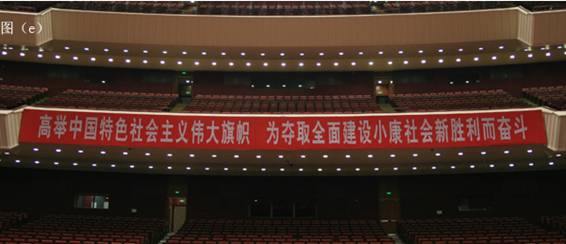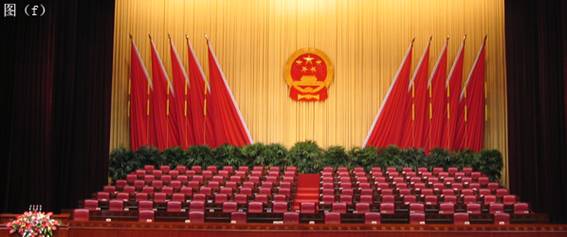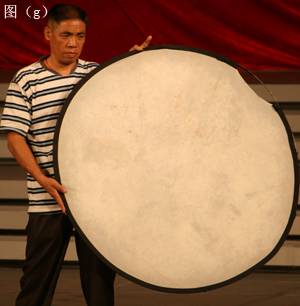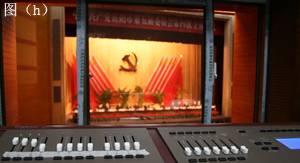[Abstract] meeting is an important means of modern management. All managers, senior managers and government departments have to plan and organize various meetings. However, for a long time, the coordination and communication among conference organizers, hall technical managers and photographers has become a long-standing problem, sometimes leading to irreparable accidents. Based on the experience of meeting lighting arrangement, the author of this paper discusses the conference technical management and white balance adjustment, which can be referred by readers.
[Key words] white balance, TV camera, color restoration, light meter.
1、 Preparation before meeting
1. The Conference team shall inform the relevant departments of the venue three days in advance, such as lighting, sound, stage machinery, high and low voltage power distribution, fire control, logistics and other departments;
2. The stage machinery shall cooperate with the Conference team to set the scene in advance after receiving the notice. As shown in (figure a): Hoisting background curtain, hanging national emblem or party emblem. When hanging, it must be the same as the background screen to avoid lighting shadow. The party flag or national flag should be installed;

3. The logistics department shall cooperate with the Conference team to erect or install the platform of the presidium on the stairs. The back row and the front row are in the shape of stairs. The general stage has been replaced by a lifting stage, which is controlled and locked by the stage mechanical technicians, and the step height is about 30-50cm, and so on; after the trapezoidal stage is completed, the red carpet is laid, and the tables and chairs are placed in place according to the number of participants on the rostrum (generally divided from the center of the main stage to both sides of the side dance stage), as shown in figure (b);

4. After the tables and chairs on the rostrum have been placed, the logistics department shall cooperate with the Conference team to adjust the height and width of the curtain strip along the curtain and the side curtain; hang the logo, and the length of the logo is basically equal to the width of the stage opening, as shown in Figure C;

(2) put the flowers in the front of the flower box as shown in Fig; Place a bunch of fresh flowers at the speaker's table, and the fresh flowers will be sent and placed by the staff of the fresh flower shop (place them two hours before the meeting, and place them in the left front of the microphone rack to block the microphone base), as shown in Figure D3;


6. The sound group should cooperate with the conference group to place the microphone in advance and put the microphone on the seat where the speaker needs to speak. The connecting wire between the microphones should be hidden under the red carpet. After all the microphones are installed in place, test the sound. Turn on the microphone at the speaker half an hour before the meeting starts;
7. After the setting, tables and chairs, acoustics and greening are ready, the lighting of the rostrum meeting will be arranged. Generally speaking, computer lights and tracking lights are not allowed to be used in conference lighting, because the color temperature of computer lights and tracking lights is high, which is inconsistent with the basic light, and the color temperature is chaotic, which is easy to affect the camera effect; if it is necessary to use a tracking lamp, the soft light paper should be added, and when the dialogue is balanced, the tracking lamp should be turned on; the average illumination of conference lighting should not be lower than 550lux, and the spot should be uniform, and a light meter should be used if necessary Half an hour before the start of the conference, the lighting engineer should cooperate with the television camera operator to turn on the lights of the audience (Fig. E) and the rostrum (Fig. f), and adjust the lighting to the appropriate brightness according to the scene, so that the photographer can balance the white. It should be emphasized that once the white balance check is completed, no one (except the photographer's strong request) can point to the lighting engineer and change the dimming brightness at will, so as not to affect the camera effect. In case of changing the brightness, it will seriously affect the white balance, affect the camera effect, and cause image color deviation. The higher the color temperature, the more blue the light color (living people will become "corpse") and the lower the color temperature, the more red. When the color temperature of one color light is higher than that of other colors, it means that the color light is bluer than other colors, otherwise it is red; similarly, when one color light is bluer than other colors, it means that the color temperature of the color light is higher, otherwise it is lower;

8. The high and low voltage power distribution group should strengthen the duty, cooperate with the lighting group and the meeting group, carry out heavy load test after the lighting is finished to check whether there is tripping and other conditions, so as to prevent errors; when major meetings or performances, it should contact the power supply department, and if necessary, ask the power supply department to wait, connect the emergency power supply, and provide emergency lighting in case of power failure;
9. In addition to the preparation of regular tea and water, the logistics team cooperated with TV reporters to open the VIP room video monitoring or live TV at the same time in advance, so that the host can keep abreast of the dynamic situation of the venue and the meeting process at any time;
10. The fire control team cooperates with the public security fire department to check the cable and fire-fighting facilities on site, and turn on the smoke detector before the meeting, so as to find out the fire situation in time. Of course, smoking is strictly prohibited in the field.
2、 White balance adjustment
1. The definition of white balance
White balance is a very important concept in the field of plane photography and television photography. It can solve a series of problems such as color restoration and tone processing. White balance is produced with the reproduction of true colors in electronic images. It has been applied earlier in professional photography. Existing household electronic products such as home cameras and digital cameras have also been widely used. With the development of electronic imaging technology, white balance adjustment becomes more and more easy to understand. However, many users still do not know the working principle of white balance There are many misunderstandings in understanding. In fact, white balance is to realize that the camera and the camera image can accurately reflect the color status of the subject. There are manual white balance, automatic white balance or custom white balance.
Many people will encounter such problems when shooting with digital cameras: the images taken in the room with fluorescent lamps will turn green, the scenery taken under the indoor tungsten light will turn yellow, and the pictures taken in the shadow of sunlight will turn blue inexplicably. The subjective reason lies in the setting of "white balance".
What is white balance?
White balance, English name is white balance, literally understanding is white balance. What is white? This involves some color knowledge, white refers to the light reflected to the human eye by the blue, green, red three color light proportion is the same and has a certain brightness formed by the visual response. We all know that white light is composed of red, orange, yellow, green, green, blue and purple, and these seven kinds of color light are formed by mixing red, green and blue primary colors in different proportions. When the proportion of three primary colors in a light is the same, people usually call it achromatic. The light reflected by black, white, gray, gold and silver is achromatic. Popular understanding of white is the brightness without color components. The white or other colors seen by the human eye are related to many factors such as the solid color of the object itself, the color temperature of the light source, the reflection or transmission characteristics of the object, and the visual induction of the human eye. For example, when a colored light irradiates an achromatic object, the color of the reflected light of the object is the same as that of the incoming light, that is, the white object is red under the red light, and two or more colored lights are illuminated at the same time When it comes to the achromatic object, the color of the object shows additive effect. If red and green light illuminate a white object at the same time, the object will be yellow. When the colored light irradiates the colored object, the color of the object shows the subtractive effect. For example, yellow objects appear red under magenta light, green under cyan light, gray or black under blue light.
Before understanding the white balance, it is necessary to clarify another very important concept color temperature. The so-called color temperature, in short, is quantitatively expressed in Kelvin temperature (k). Kelvin, a famous British physicist, thinks that if a certain blackbody can absorb all the heat falling on it without loss, and at the same time release all the energy generated by heat in the form of "light", it will change into different colors due to the level of heat. For example, when the heat received by the black body is equal to 500-550 ℃, it will turn dark red. When it reaches 1050-1150 ℃, it will turn yellow. If the temperature continues to rise, it will turn blue. The color composition of the light source is corresponding to the thermal temperature of the blackbody. The color temperature of any light is equivalent to the "temperature" when the blackbody emits the same color. This temperature is used to indicate the characteristics of a certain color light to distinguish others. This is the color temperature. In the process of tapping, black iron gradually turns red at furnace temperature, which is the best example of blackbody theory. Color temperature phenomenon is very common in daily life, I believe people are not unfamiliar with it. The light emitted by tungsten filament lamps is yellow due to its low color temperature. Different street lamps also emit different colors of light. The flame of natural gas is blue because of its high color temperature. The color temperature of cloudless blue sky is about 10000 K, that of cloudy day is about 7000-9000 K, that of sunny day under direct sunlight is about 6000 K, that of sunrise or sunset is about 2000 K, and that of candle light is about 1000 K. At this time, it is not difficult to find a rule: the higher the color temperature, the more blue the light color; the lower the color temperature, the more red. When the color temperature of one color light is higher than that of other colors, it means that the color light is bluer than other colors, otherwise it is red; similarly, when one color light is bluer than other colors, it means that the color temperature of the color light is higher, otherwise it is lower.
Because of the unique adaptability of the human eye, we can not find the change of color temperature sometimes. For example, if you stay under a tungsten lamp for a long time, you will not feel that the white paper under the tungsten lamp is red. If you suddenly change the fluorescent lamp to the tungsten lamp, you will feel the color of the white paper is red, but this feeling can only last for a while. The CCD of the camera is not as adaptable as the human eye, so if the color adjustment of the camera is inconsistent with the color temperature of the scene lighting, color deviation will occur. So what is white balance? White balance is to adjust the internal color circuit of the camera to offset the color deviation under different color temperature conditions, which is closer to the visual habits of human eyes. White balance can be simply understood as that under any color temperature conditions, the standard white captured by the camera lens is still white after the circuit is adjusted. This is a common, but not all, white balance is actually through the internal circuit adjustment of the camera (changing the balance of the three CCD levels of blue, green and red) to make the light reflected into the lens appear achromatic. If the white balance is adjusted with a reddish hue, the image of that color light is achromatic, and the scenery of other colors will be bluish (complementary color relationship).
So what is "white balance"? The color of light reflected by objects depends on the color of the light source. The reason why human eyes regard some objects as white is that the human brain can detect and correct such color changes. Therefore, the color of white objects that people see remains unchanged no matter in sunlight, cloudy weather, indoors or under fluorescence. The human eye can adapt itself, but the digital camera does not have such intelligent function. This is because the CCD sensor itself does not have this adaptive function. In order to be close to the human visual standard, the digital camera must imitate the human brain and adjust the color according to the light, that is, it needs to automatically or manually adjust the white balance to achieve satisfactory color The white balance sensor is usually located under the lens, which can automatically sense the surrounding environment and adjust the color balance. This process of correcting the output signal of digital camera is called white balance adjustment. Master the adjustment of white balance, you can shoot the real color picture. At present, all digital cameras on the market have the function of automatic adjustment of white balance, which is more convenient to use. Some types of digital cameras also have manual white balance adjustment. The accuracy of manual adjustment is better than that of automatic adjustment. In addition, some preset modes, such as cloudy day, sunny day and fluorescent lamp, can be adjusted according to the use environment, which is relatively convenient. Due to the different spectral characteristics of different lighting conditions, the photos are often colored, such as blue under fluorescent lamp, yellow under incandescent lamp, etc. In order to eliminate or reduce the color deviation, digital cameras and cameras can adjust the color settings according to different light conditions, so as to make the color of the photo as undistorted as possible and restore the color to normal. Because this adjustment is often based on white, it is called white balance.
2. Working principle of white balance
White balance is a very abstract concept. The most popular understanding is to let the image made by white remain white. If white is white, the image of other scenery will be close to the color visual habit of human eyes. The process of white balance adjustment is called white balance adjustment. There are three ways of white balance adjustment in the early stage equipment: preset white balance, manual white balance adjustment and automatic tracking white balance adjustment. Usually, according to the white balance adjustment procedure, push the white balance adjustment switch, the white balance adjustment circuit starts to work, automatically completes the adjustment work, and records the adjustment results. If you master the working principle of white balance, it will be more targeted and handy.
The white balance works like this: there are three CCD electronic coupling elements in the camera, which can sense the blue, green and red light respectively. Under the preset condition, the electronic amplification ratio of these three photosensitive circuits is the same, which is 1:1:1. The adjustment of white balance is to change the proportion relationship according to the adjusted scene. For example, the proportion of blue, green and red light of the adjusted scene is 2:1:1 (the proportion of blue light is more than that of high color temperature), then the ratio after white balance adjustment is 1:2:2. After the adjustment of circuit amplification ratio, the proportion of obvious blue is reduced, and the ratio of green and red is increased. In this way, the adjusted scene can be transferred to the captured image through the white balance adjustment circuit The proportion of red is the same. In other words, if the adjusted white is slightly blue, the white balance adjustment will change the normal proportional relationship, weaken the amplification of the blue circuit, and increase the ratio of green and red, so that the resulting image is still white.
Another way of thinking is to consider the problem of white balance adjustment. The camera will not "reject" the adjusted scene placed in front of the lens within the white balance adjustment tolerance, that is, the lens can adjust the white balance to any scene. Most of the time, the white board (card) is used to adjust the white balance, because the white board (card) can most effectively reflect the color temperature of the environment. In fact, most of the time, the white board (card) in a certain environment is not white, more or less inclined to a little blue or other colors. Experienced camera will also use the blue sky to adjust the white balance, so as to get a picture with red and yellow tone 。 After understanding the working principle of white balance, we can boldly try different effects when using it again, which enriches the content of camera creation.
3. White balance adjustment
In life, the color temperature of sunlight is constantly changing. It can be said that there are no two places where the color temperature will be exactly the same. Different regions, seasons, ground environment, weather, morning and evening will affect the color temperature. There are also a large number of artificial light sources, and the color temperature is not the same. There are three ways to adjust the white balance: coarse adjustment, fine adjustment and automatic tracking (ATW): coarse adjustment refers to changing the color temperature filter under preset conditions to make the color temperature close to 3200K; fine adjustment refers to getting a more accurate adjustment result for specific environment color temperature through the camera white balance adjustment function under the cooperation of color temperature filter Automatic tracking refers to the automatic tracking function (ATW) of the camera to adjust itself according to the color temperature change of the picture.
The preset function is to set the blue, green and red photographic balance of the camera at 3200K color temperature. When the ambient color temperature is 3200K, the camera color temperature filter is placed at 3200K, the scene can get the correct color restoration; when the ambient color temperature is 5600k, the camera color temperature filter is placed at 5600k, the scene can get the correct color restoration. When the ambient color temperature is within the range of 3200K, 1000K and 6000K, the color restoration acceptable to human eyes can be obtained by using the white balance preset function. Because the color temperature deviation is not large, the captured images show subtle color changes. This has an advantage. Different living environment itself will have different color tone due to the influence of environmental color and lighting difference. If you adjust white everywhere, different environment will present a single white light lighting effect, and using white balance preset can keep this rich color change.
In general, the fine whitening method is to adjust the white balance with the whiteboard (card) along the shooting direction in the shooting environment. This is a common situation, there are several very flexible fine whitening methods. Use a standard white board with good transmittance, place it in front of the lens, and adjust the white balance in the shooting environment by facing the lighting direction of the light source or the main shooting direction. A professional camera will give a color temperature reading, such as 5000K. If you want to shoot a normal picture, use this white balance result to shoot. In camera creation, sometimes we want to get a picture with color deviation to achieve the purpose of creation. At this time, we can use any scenery to adjust the white balance. The color temperature of the adjusted white scene is complementary to the color deviation of the picture. The red white picture is inclined to cyan, the green one to the magenta, and the blue color to the yellow. The automatic tracking function of white balance (ATW) is real-time adjusted according to the color temperature of the scene captured by the lens. If the color temperature of the object captured by the lens changes (the color temperature of the scene absorbed by the lens is different from the color temperature of the ambient lighting), the color of the picture will change in one lens head. For example, if the lens is pushed close to the face by the panoramic view of the characters, the color temperature of the lens will be different due to the change of scene, and the skin color of the characters in the picture will also change. Therefore, this mode is not recommended for special cases.
Conference lighting is not equal to performance lighting. Conference lighting is simply white light without adding any color, such as color paper, color changer, etc. Because after adding color, it will cause color deviation and seriously affect the camera effect. Keep the white light to keep the original skin color of the portrait, the effect is better. When adjusting the white balance, the cameraman and the lighting engineer should cooperate closely. When the cameraman stands on the stage, holding a piece of white cloth or paper (usually white cloth) as shown in (Fig. g), the lighting engineer should adjust the meeting lighting of the auditorium and the rostrum to the appropriate scale, and make records, as shown in (Fig. h). After all the camera positions have been aligned to white balance (the cameraman will make gestures after the completion), the rostrum light will be turned off. Before the participants enter the venue, the lighting engineer slowly adjusts the light to the original recording scale to prepare for the formal meeting. In the process of the conference, never change the lighting intensity of the rostrum or auditorium at will, in case the color temperature is too high or too low.


3、 Summary
The planning and preparation of the conference are very complicated. The layout of the venue is one of the very important preparatory links. The effective communication between the conference management team and the technical personnel and the television camera personnel is the technical guarantee to ensure the smooth completion of the conference. White balance adjustment is not only the basic skill of photography, but also an important creative means. After making clear the principle, we can apply it freely if we study and use it flexibly, and we will get some results in practice.
In a word, whether it is a meeting or a performance, all departments need to cooperate closely, do their own work in place, and self check their own work to ensure the success of the meeting.